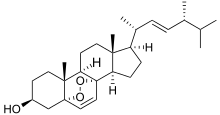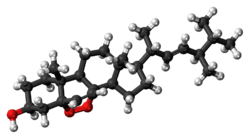Ergosterol peroxide
 | |
 | |
| Names | |
|---|---|
| IUPAC name
(3S,5S,8S,9R,10R,13R,14R,17R)-10,13-dimethyl-17-[(1R,2E,4R)-1,4,5-trimethylhex-2-en-1-yl]-1,3,4,9,10,11,12,13,14,15,16,17-dodecahydro-2H-5,8-epidioxycyclopenta[a]phenanthren-3-ol | |
| Identifiers | |
| 2061-64-5 | |
| ChEBI | CHEBI:65858 |
| ChEMBL | ChEMBL434750 |
| ChemSpider | 4508532 |
| |
| Jmol-3D images | Image |
| PubChem | 5351516 |
| |
| Properties | |
| C28H44O3 | |
| Molar mass | 428.647 |
| Density | 1.08g/cm3 |
| Boiling point | 499.7 °C (931.5 °F; 772.8 K) at 760mmHg |
| Hazards | |
| Flash point | 256 °C (493 °F; 529 K) |
| Except where noted otherwise, data is given for materials in their standard state (at 25 °C (77 °F), 100 kPa) | |
| Infobox references | |
Ergosterol peroxide (5α,8α-epidioxy-22E-ergosta-6,22-dien-3β-ol) is a steroid derivative. It has been isolated from a variety of fungi, yeast, lichens and sponges,[1][2][3][4][5] and has been reported to exhibit immunosuppressive,[6] anti-inflammatory,[7] antiviral,[8] and antitumor activities in vitro.[9][10]
References
- ↑ Lobo AM, Abreu PM, Prabhakar S, Godhino LS, Jones R, Rzepa HS, Williams DJ. (1988). "Triterpenoids of the fungus Pisolithus tinctorius". Phytochemistry 27 (11): 3569–74. doi:10.1016/0031-9422(88)80770-2.
- ↑ Jimenez C, Quinoa E, Rignera R, Vilalta R, Quintella JM. (1989). "The dietary origin of epidioxy steroids in Actinia equina. A carbon14 incorporation experiment". Journal of Natural Products 52 (3): 619–22. doi:10.1021/np50063a023.
- ↑ Kahols K, Kangas L, Hiltunen R. (1989). "Ergosterol peroxide, an active compound from Inonotus radiatus". Planta medica 55 (4): 389–90. doi:10.1055/s-2006-962036. PMID 2813575.
- ↑ Tchouankeu JC, Nyasse B, Tsamo E, Sondengam B, Morin C. (1992). "An ergostane derivative from the bark of Entandrophragma utile". Phytochemistry 31 (2): 704–705. doi:10.1016/0031-9422(92)90067-Z.
- ↑ Fujimoto H, Nakayama Y, Yamazaki M. (1994). "Isolation and characterization of immunosuppressive components of three mushrooms, Pisolithus tinctorius, Microporus flabelliformis and Lenzites betulina". Chem. Pharm. Bull. 42: 694–97. doi:10.1248/cpb.42.694.
- ↑ Yasukawa K, Akihisa T, Kanno H, Kaminaga T, Izumida M, Sakoh T, Tamura T, Takido M. (1996). "Inhibitory effects of sterols isolated from Chlorella vulgaris on 12-O-tetradecanoylphorbol-13-acetate-induced inflammation and tumor promotion in mouse skin". Biological and Pharmaceutical Bulletin 19 (4): 573–576. doi:10.1248/bpb.19.573. PMID 8860961.
- ↑ Lindequist U, Lesnau A, Teuscher E, Pilgrim H. (1989). "Antiviral activity of ergosterol peroxide". Pharmazie 44 (8): 579–80. PMID 2594833.
- ↑ Nakanishi T, Murata H, Inatomi Y, Inada A, Murata J, Lang FA, Yamasaki K, Nakano M, Kawahata T, Mori H, Otake T. (1998). "Screening of anti-HIV-1 activity of North American plants. Anti-HIV-1 activities of plant extracts, and active components of Lethalia vulpina (L.) Hue". Journal of Natural Medicines 52: 521–26.
- ↑ Bok JW, Lermer L, Chilton J, Klingeman HG, Towers NGH. (1999). "Antitumor sterols from the mycelia of Cordyceps sinensis". Phytochemistry 51 (7): 891–98. doi:10.1016/S0031-9422(99)00128-4.
- ↑ Nam KS, Jo YS, Kim YH, Hyun JW, Kim HW. (2001). "Cytotoxic activities of acetoxyscirpenediol and ergosterol peroxide from Paecilomyces tenuipes". Life Sciences 69: 229–37. doi:10.1016/s0024-3205(01)01125-0.